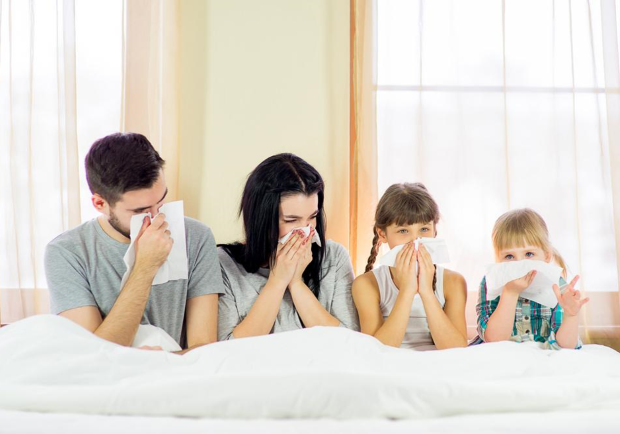While pet hair and dander are an obvious allergy trigger, dust mites are not visible to the naked eye.
And neither are gaseous substances such as ozone, nitrogen dioxide, and formaldehyde. In fact, you might be shocked to discover the allergens lurking around that constantly cause a runny nose or itchy eyes. And that’s just the minor symptoms.
The majority of your time is spent inside your home, so if you are not aware of the possible allergens, it could be hurting your quality of life. Additionally, if you can’t breathe easily inside your home it will also make getting a good nights’ sleep difficult preventing you from being your best during the day.
Here are nine surprising allergy triggers that might be hiding in your home.
1. Carpets
Carpet flooring and even carpet rugs within your home may be a major allergy trigger. Even if you vacuum on a routine basis, there may be a much better flooring option for your lifestyle.
Available are numerous allergy-friendly flooring options that are much more suitable than carpet. For instance, hard surface flooring such as hardwoods, vinyl, and laminate can eliminate questionable allergens such as dust mites and mold. However, be sure to stay away from more rustic hardwoods as they can collect dust within the grooves.
Hardwood floors are also much more durable and easier to maintain than carpet. You do not have to worry about spills or messes from pets or children.
2. Remodeling
Besides the fact that carpet can collect dust and mites, allergies can also be triggered by new home renovations.
Formaldehyde and Volatile Organic Compounds (VOCs) are two surprising allergy triggers you may never consider. If you’re in the process of choosing new flooring or picking paint chips for a fresh coat, seek out materials that are formaldehyde-free or low-VOC.
Should you opt for a material that is not, at least be sure to ventilate the area well before exposure. Otherwise, these harsh chemicals may irritate and cause allergic reactions—even severe ones.
Some of these common irritants that trigger allergies are carpet glues, the foam padding in sofas and chairs and even particle board cabinets and case goods furniture.
3. Bathroom Mold
Bathrooms are the wettest room in the house. So, it’s no surprise that it develops mold, which can contribute to allergies.
Install a ventilation fan and turn it on during steamy showers. By keeping the air circulated, you can reduce mold and moisture.
If you rent a home and cannot easily install a ventilation fan, you can simply open a window or leave the bathroom door cracked open to let out any moisture or steam. A free-standing dehumidifier can be used instead of installing a ventilation fan to help dry out your bathroom and prevent any mold to build up.
You should also be sure to clean around areas that see the most moisture, such as the toilet, sink, bathtub or shower. Keeping these areas clean and disinfected on a routine basis can eliminate mold.
4. Dust Mites
While a bathroom will always have moisture, the rest of your home should be fairly neutral. It should not have too much that it allows dust mites to populate.
Dust mites thrive off dead skin cells and humid environments. They also thrive in bedding, carpets, a child’s stuffed animals and even pet beds. Unfortunately, they also leave behind skin and fecal matter, which adds to their allergenic qualities and can create anything from a skin rash to coughing and watery eyes.
5. Humidity Levels
Too much or too little humidity can trigger allergies. Obviously, high humidity levels can create mold and allow dust mites to thrive. But low humidity levels that make air dry can also be bad for us, causing congestion and a stuffy nose.

Fortunately, your home’s humidity levels are easy to track with a hygrometer device. Simply take measurements for temperature and relative humidity (RH) and aim for 40 to 50 percent. In winter months, you can aim slightly lower to combat condensation.
There are many free-standing humidifiers and de-humidifying options to help regulate the humidity levels in your home. If the humidity levels in rooms vary, you can invest in one to try and level out the humidity and make breathing much easier.
6. Cleaning Devices
Believe it or not, some of the very equipment and cleaning agents we use could be hidden culprits and allergy triggers.
Some cleaning agents, especially spray cleaners, can be quite problematic for homeowners–especially if used in excess. The chemicals themselves are sprayed on the counter surface but tend to linger in the air for longer than we anticipate.
Vacuum cleaners are also a hidden culprit. While they seem to suck up dirt and pet hair that is visible to the naked eye, there are still fine particulates that only get recycled back into the home. The best way to combat these fine allergy-inducing particulates is to do away with low-efficiency vacuums and use a HEPA (high-efficiency particulate air) filter or central vacuum instead.
Be sure to clean out your vacuum regularly to prevent dust from being recycled back into the home. Emptying the tray and cleaning the filter is particularly important so your vacuum can perform its best and gather dust, not distribute it.
7. Ozone Gas
Ozone gas can be one surprising allergy trigger as it hides in certain devices with filters and air cleaners. Just as people with asthma check ozone levels each day, so should they be checking indoor levels.
Some devices, such as ionic or ionizing air filters, can even circulate ozone gas. By essentially sending large amounts of voltage through the air, they produce varying, and sometimes dangerous, levels of ozone.

While ozone gas has long been an established pollutant, you might question why these devices are still on the shelves.
Some manufacturers have reduced their ozone, but others still squeak by with a limited fact sheet that fails to mention the ozone side effects. If you suffer from asthma or allergies, keep ionic and ionizing air purifiers out of the house.
8. Nitrogen Dioxide
Nitrogen dioxide emissions originate from vehicles as well as other engine-operated machines and are primarily recognized as an outdoor pollutant. However, it can still be found in our homes.
While you may never think about it as you boil pasta or cozy up by the fire in winter, gas stoves, fireplaces, and wood-burning stoves can emit nitrogen dioxide when used. That’s why it’s essential that these have adequate ventilation and are not redistributed back into the home. When nitrogen dioxide is not vented correctly, it can build up indoors and cause allergic reactions.
9. Outside Allergens
Of course, outside allergens make their way into our homes as well–but in ways, you might not expect. It’s not simply the pollen. It’s the grass your shoes carry in and it’s the cat dander on your friend’s coat.
The best way to keep these outside allergens at bay is to take preventative measures. Create a space toward the front door or foyer to remove and keep shoes neatly stored. The same concept goes for coats.
There’s no way to keep these allergy triggers from entering the home, but quarantining certain elements and carriers can keep them under control.
If you have pets, they can carry in outside allergens. Be sure to keep them clean and be aware of the dust and particles they track in, especially in the spring.
Have Any Allergy Symptoms?
If you can’t control your allergies, remember that it might not be the obvious spring pollen or the clogged filters you’ve meant to replace. It could be something less conspicuous.
For instance, humidity plays a significant role in allergens, allowing dust mites to thrive and bathrooms to become moldy. So, take a look around and consider if you have one of these nine surprising allergy triggers that might be hiding in your home. Eliminating possible allergy triggers in your own home could drastically improve your quality of life and allow you to breathe and feel better.

























































































the main problems are not so-called allergens but adjuvants used in nowadays vaccines to sensitize immune system.
Allergy to cow’s milk causes excess mucus in the throat, lungs and nose and in extreme it can threaten to block your airways. I know from experience after spending a day living only on hot milk drinking chocolate etcetera when trying to finish making a fence in the quickest possible time on a cold day. Even now it causes issues and was a big problem until I discovered Lagundi Leaf extract for coughs, which is a natural mucolitic (loosens mucus). It is a certified medicine here in the Philippines and we now grow it in our garden.